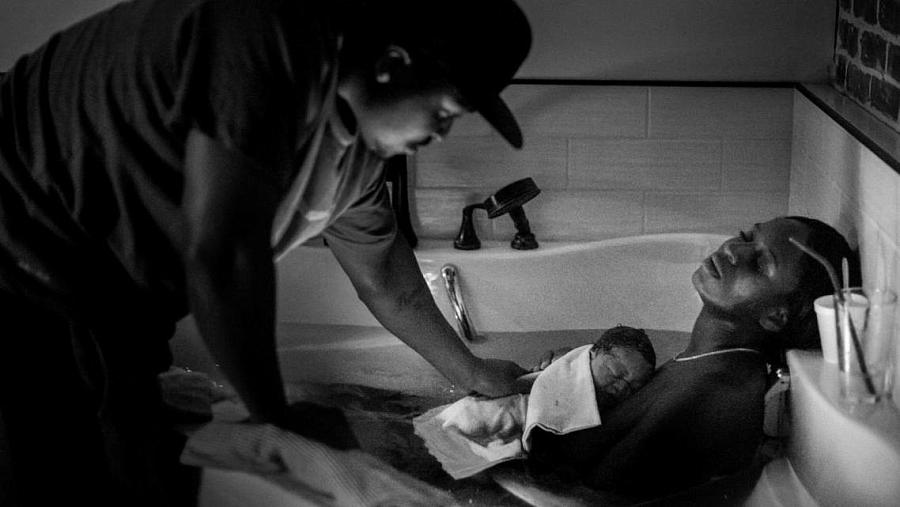For series on midwives and home births, being there made all the difference

Aysha-Samon Stokes rests in the birthing bath at Kindred Space LA’s South LA birthing center on Mother’s Day, 2021.
Photo by Sarah Reingewirtz/Los Angeles Daily News/SCNG
I was sitting in my car sipping a cup of coffee and waiting for Aysha-Samon Stokes.
Across the street in a park, women pushed their strollers. Children ran across the field, kicking a ball. A peacock crossed the road and stopped in front of my car. I was not sure whether I made the right decision to meet someone in person.
I looked at my watch as a text message popped up on my screen.
“I'll be there in 10 minutes,” Stokes’ text message said.
She and I were supposed to meet about an hour and a half ago at the park in Culver City.
Stokes was about eight months pregnant and took care of a family with two children while figuring out how to deliver her baby at home in the middle of the pandemic. Meeting a reporter was probably not her highest priority, I thought.
Still, I grew impatient.
For the prior six months, I got used to making Zoom calls and chatting over the phone with most of my sources. I appreciated how quickly I could join a government meeting or press conference. I was also exhausted from sleepless nights and anxious about separating with my 9-month-old son.
But home birth was a new idea to me, and I wanted to meet as many expectant moms as possible and figure out why they wanted to avoid hospitals, why they felt it was safe to deliver a baby in a place not equipped to handle an emergency and what kind of challenges expectant mothers like Stokes were facing while accessing medical care.
As I worked through my five-part series on home births, I interviewed dozens of doulas, midwives and government officials over the phone. Still, I felt I was missing the voices of people I was writing about, the women who opted for home birth.
As I was watching the peacock walking past my car, I decided to wait for Stokes as long as needed.
When she arrived with her 6-year-old daughter Nyla, and 2-year-old son Wyatt, she gave me a big hug. I instantly felt the connection.
We walked into the park where Stokes chatted with other moms and played with her kids. One of Nyla’s friends spotted Stokes’ belly, put a ball under her shirt and offered Stokes to shake their bellies together. Stokes quickly agreed.
When we stepped aside, Stokes talked about her personal journey, sharing details about the complications she experienced with her previous pregnancies, her painful deliveries in the hospital and the way medical staff had treated her, making her feel unheard and unseen. She just couldn't bear the thought of going back to the hospital the third time; she felt as if home birth was her only option.
As I was leaving the park, I had videos and photos of Stokes on my phone along with a notebook full of notes. I had a much better understanding of why she had opted for a home birth. There was no way she would have opened up the same way without our meeting.
I made some progress on my project, but at times it was particularly difficult to find expectant mothers who would agree to let our photographer be with them during the delivery. I compiled a list of about 40 midwives and doulas and decided to keep calling them, asking to connect with expectant mothers until I was able to find the right person.
That’s how I found Racha Tahani Lawler, a midwife with 20 years of experience who attended hundreds of home births while commuting to Oakland and Long Beach and training an army of student midwives.
When Lawler agreed to meet in person, I didn’t think twice before heading to her Long Beach home.
In the early days of the pandemic, she began growing vegetables, herbs and fruit in her backyard so she could fill a bag and take it to her clients — some of them struggled to afford fresh produce. She built a large tent in her backyard with a chair, sink and small table so pregnant people and their partners who didn’t have a backyard could come and spend time outdoors.
Lawler shared stories of women she encountered during the pandemic who struggled with anxiety, depression and isolation. At times, Lawler visited her clients just to listen to them and hold their babies without giving any recommendations.
As my colleague and photographer Sarah Reingewirtz and I were leaving Lawler’s home, I felt like we had covered only a tip of the iceberg. Our interview turned into three separate stories about the shortage of Black midwives, the difficulty of opening a birth center in an underserved community, and the challenges women and midwives faced during home deliveries.
Stokes delivered her baby boy on Mother’s Day in a birth center in South Los Angeles.
Two weeks later, Sarah and I drove to Kindred Space LA birth center hidden in a storefront next to a liquor store, to meet with Stokes’ midwives.
Midwife Allegra Hill greeted us in the center’s small kitchen and offered a bowl of freshly cooked lentil soup. Stokes sat on a sofa as her children played on the patio.
Allegra asked Stokes questions about hydration, diet, mood and water intake. After spending two hours in the birth center, I asked Stokes if she was happy with the quality of care she had received. For the first time since her first pregnancy, she said, she felt seen, heard and cared for.
As for me, I was happy I spent another day with Stokes and had a chance to learn more about midwifery than I would never be able to capture over the phone.

